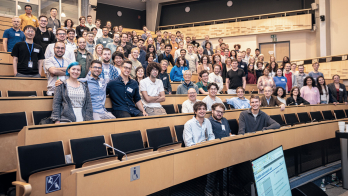
Recent measurements bolstering the longstanding tension between the experimental and theoretical values of the muon’s anomalous magnetic moment generated a buzz in the community. Though with a much lower significance, a similar puzzle may also be emerging for the anomalous magnetic moment of the electron, ae.
Depending on which of two recent independent measurements of the fine-structure constant is used in the theoretical calculation of ae – one obtained at Berkeley in 2018 or the other at Kastler–Brossel Laboratory in Paris in 2020 – the Standard Model prediction stands 2.4σ higher or 1.6σ lower than the best experimental value, respectively. Motivated by this inconsistency, the NA64 collaboration at CERN set out to investigate whether new physics – in the form of a lightweight “X boson” – might be influencing the electron’s behaviour.
The generic X boson could be a sub- GeV scalar, pseudoscalar, vector or axial- vector particle. Given experimental constraints on its decay modes involving Standard Model particles, it is presumed to decay predominantly invisibly, for example into dark-sector particles. NA64 searches for X bosons by directing 100 GeV electrons generated by the SPS onto a target, and looking for missing energy in the detector via electron–nuclei scattering e–Z → e–ZX.
The result sets new bounds on the e–X interaction strength
Analysing data collected in 2016, 2017 and 2018, corresponding to about 3 × 1011 electrons-on-target, the NA64 team found no evidence for such events. The result sets new bounds on the e–X interaction strength and, as a result, on the contributions of X bosons to ae: X bosons with a mass below 1 GeV could contribute at most between one part in 1015 and one part in 1013, depending on the X-boson type and mass. These contributions are too small to explain the current anomaly in the electron’s anomalous magnetic moment, says NA64 spokesperson Sergei Gninenko. “But the fact that NA64 reached an experimental sensitivity that is better than the current accuracy of the direct measurements of ae, and of recent high-precision measurements of the fi ne-structure constant, is amazing.”
In a separate analysis, the NA64 team carried out a model-independent search for a particular pseudoscalar X boson with a mass of around 17 MeV. Coupling to electrons and decaying into e+e– pairs, the so-called “X17” has been proposed to explain an excess of e+e– pairs created during nuclear transitions of excited 8Be and 4He nuclei reported by the “ATOMKI” experiment in Hungary since 2015.
The e-X17 coupling strength is constrained by data: too large and the X17 would contribute too much to ae; too small and the X17 would decay too rarely and too far away from the ATOMKI target. In 2019, the NA64 team excluded a large range of couplings, although at large values, for a vector-like X17. More recently, they searched for a pseudoscalar X17, which has a lifetime about half that of the vector version for the same coupling strength. Re-analysing a sample of approximately 8.4 × 1010 electrons-on-target collected in 2017 and 2018 with 100 and 150 GeV electrons, respectively, the collaboration has now excluded couplings in the range 2.1–3.2 × 10–4 for a 17 MeV X-boson.
“We plan to further improve the sensitivity to vector and pseudoscalar X17’s after long shutdown 2, and also try to reconstruct the mass of X17, to be sure that if we see the signal it is the ATOMKI boson,” says Gninenko.
Further reading
NA64 Collab. 2021 Phys. Rev. Lett. 126 211802.
NA64 Collab. 2021 arXiv:2104.13342
NA64 Collab. 2020 Eur. Phys. J. C 80 1159.








